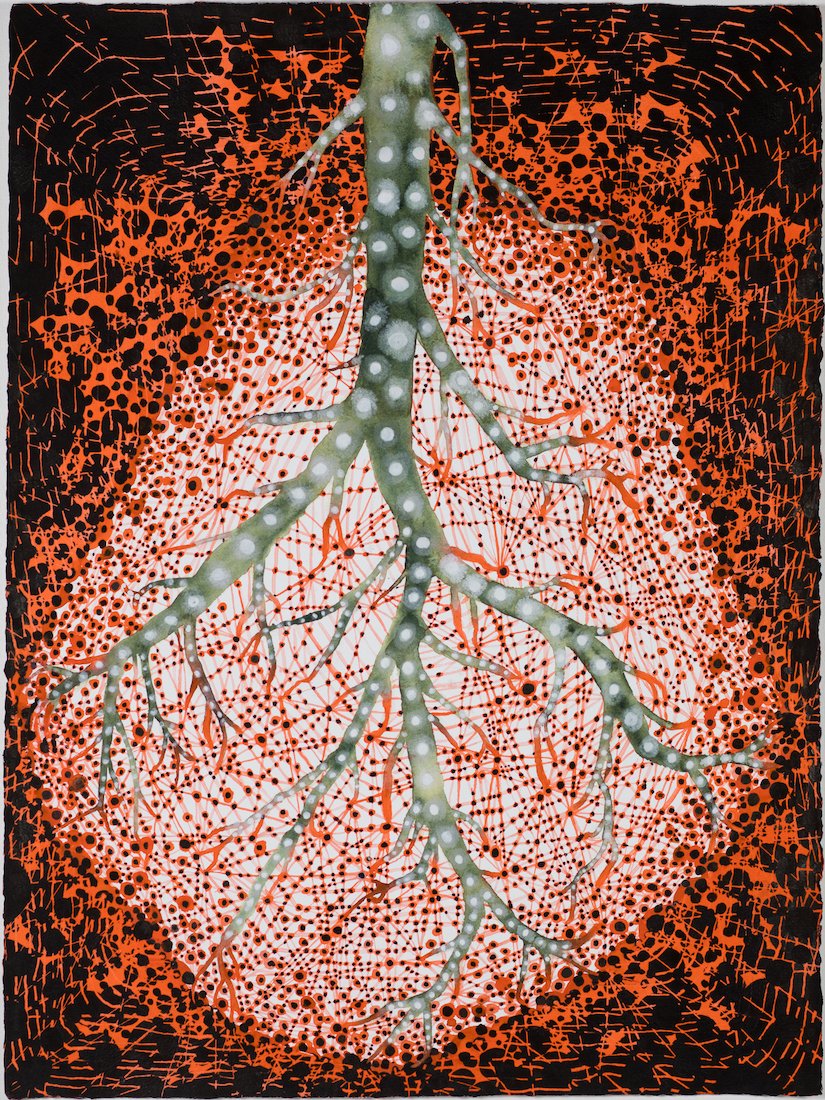Elegy to the Underground Series 2019-2022
Works on Paper
There is nothing purely human, the vegetal exits in all that is human, and the tree is at the origin of all experience. ― Emanuele Coccia
But down deep, at the molecular heart of life we’re essentially identical to trees. ― Carl Sagan
Outsiders discovered how seeds remember the seasons of their childhood and set buds accordingly. Outsiders discovered that trees sense the presence of other nearby life. That a tree learns to save water. That trees feed their young and synchronize their masts and bank resources and warn kin and send out signals to wasps to come and save them from attacks. “Here’s a little outsider information, and you can wait for it to be confirmed. A forest knows things. They wire themselves up underground. There are brains down there, ones our own brains aren’t shaped to see. Root plasticity, solving problems and making decisions. Fungal synapses. What else do you want to call it? Link enough trees together, and a forest grows aware. ― Richard Powers, The Overstory
Trees inevitably hold a major part of the answer, as the world struggles to stave off climate catastrophe. Yet, mass deforestation continues. According to the World Bank, between 1990 and 2016, the world lost 502,000 square miles of forest.
In the book, the Hidden Life of Trees, Peter Wohlleben makes the case that the forest is a social network where trees engage in social behaviors, communicating with one another through a vast network of roots. They are not simply individual entities but part of a much larger, complex system that communicates and responds as an organism. There is a whole ecosystem that lives and thrives at the top, around, and in a tree. Through its whole life and even after it is dead and decaying, a tree supports the life around it. Fearing and mourning their heartbreaking loss, these works constitute elegies, alternately acting as tributes and memorials to trees.
Sarah Slavick, Elegy to the Underground 1, 2019, watercolor, gouache on arches, 30" 22.5"
Sarah Slavick, Elegy 2, 2019, watercolor, gouache, and ink on arches paper, 30" X 22.5"
Sarah Slavick, Elegy to the Underground 3, 2019, watercolor/gouache/ink on arches, 30" 22.5"
Sarah Slavick, Elegy to the Underground 4, 2019, watercolor and gouache on arches, 30" 22.5"
Sarah Slavick, Elegy to the Underground 5, 2019, watercolor, gouache on arches, 30" 22.5"
Sarah Slavick, Elegy to the Underground 6, 2019, watercolor, gouache, ink on arches, 30" 22.5"
Sarah Slavick, Elegy to the Underground 7, 2019, watercolor, gouache on arches, 30" 22.5"
Sarah Slavick, Elegy to the Underground 8, 2019, watercolor, gouache. ink on arches, 30" 22.5"
Sarah Slavick, Elegy to the Underground 9, 2019, watercolor, gouache, ink on arches, 30" 22.5"
Sarah Slavick, Elegy to the Underground 11, 2020, watercolor, gouache, ink on arches, 30" 22.5"
Sarah Slavick, Elegy to the Underground 10, 2020, watercolor, gouache, ink on arches, 30" 22.5"
Sarah Slavick, Elegy to the Underground 12, 2020, watercolor, gouache on arches, 30" 22.5"
Sarah Slavick, Elegy to the Underground 13, 2020, watercolor, gouache, ink on arches, 30" 22.5"
Sarah Slavick, Elegy to the Underground 14, 2020, watercolor, gouache ink on arches, 30" 22.5"
Sarah Slavick, Elegy to the Underground 15, 2020, watercolor, gouache, ink on arches, 30" 22.5"
Sarah Slavick, Elegy to the Underground 16, 2020, watercolor, gouache, ink on arches, 30" 22.5"
Sarah Slavick, Elegy to the Underground 17, 2021, watercolor, gouache on arches, 30" 22.5"
Sarah Slavick Elegy to the Underground 18, 2021, watercolor, gouache, ink on arches, 30" 22.5"
Sarah Slavick, Elegy to the Underground 19, 2021, watercolor, gouache, ink on arches, 30" 22.5"
Sarah Slavick, Elegy to the Underground 20, 2021, watercolor, gouache, ink on arches, 30" 22.5"
Sarah Slavick, Elegy to the Underground 21, 2021, watercolor, gouache, ink on arches, 30" 22.5"
Sarah Slavick, Elegy to the Underground 22, 2021, watercolor, gouache, ink, flasche on arches, 30" 22.5"
Sarah Slavick, Elegy to the Underground 22, 2022, watercolor/gouache/ink on arches, 30" 22.5"






















